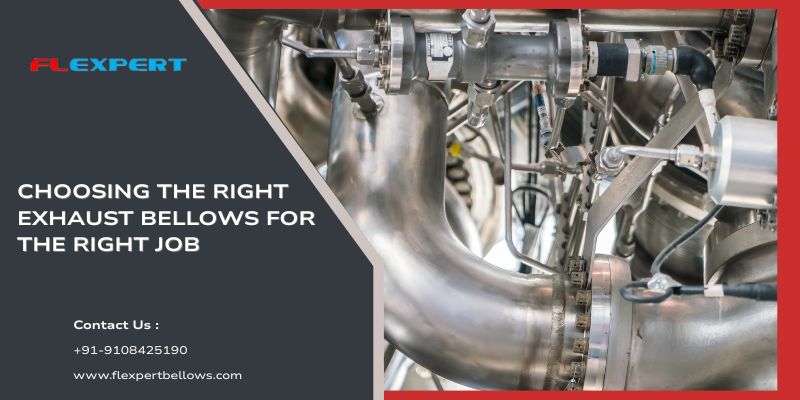
Ever wondered why some exhaust systems last longer, even under extreme pressure and heat? It’s not magic—it’s engineering. And a big part of that magic lies in choosing the right kind of exhaust bellows for the job. Whether you’re managing a power plant or a high-performance vehicle, bellows make all the difference.
As an exhaust pipe bellows manufacturer would tell you, not all bellows are created equal. Their design, structure, and intended application play a massive role in how effectively they manage thermal expansion, vibration, and pressure changes.
What Are Exhaust Bellows, Anyway?
Exhaust bellows—also known as expansion joints—are flexible connectors installed in piping systems to absorb movement, thermal expansion, vibrations, and misalignments. Think of them as the shock absorbers of piping infrastructure. Without them, metal pipes would crack, leak, or simply give up under the strain.
Different Types of Exhaust Bellows & Their Applications
1. Axial Bellows
These are the most common type. Axial bellows are designed to absorb movement in the axial direction—along the pipe’s length. They’re often used in systems where thermal expansion and contraction are expected in a straight line.
- Application: Power plants, oil refineries, and industrial exhaust systems.
- Fun Fact: They’re simple in design but mighty in impact. A well-placed axial bellow can prevent catastrophic pipeline failures.
2. Lateral Bellows
Need to manage movement perpendicular to the pipe? Enter lateral bellows. These are built to handle sideways shifts and are often used in pairs with tie rods or hinges.
- Application: HVAC ductwork, marine exhaust systems, and chemical plants.
- Pro Insight: They’re great for complex pipe routing, where thermal movement isn’t always straight and predictable.
3. Universal Bellows
These are a two-ply solution—literally. Universal bellows combine two axial bellows with a central pipe, allowing movement in multiple directions: axial, lateral, and angular. Versatile and robust.
- Application: Large industrial duct systems, gas turbines, and boiler exhaust lines.
- Why It Matters: When one direction isn’t enough, universal bellows step in. Ideal for systems with multi-directional stresses.
4. Hinged and Gimbal Bellows
These are engineered for angular movement only. Hinged bellows allow rotation in one plane, while gimbal bellows handle rotation in multiple planes. Think of them as the joints in a human shoulder vs. an elbow.
According to a seasoned gimbal expansion bellows manufacturer, these types are invaluable in systems where pressure thrust must be restrained while still allowing angular flexibility.
How to Choose the Right Bellow?
It’s not about choosing the most expensive or the most flexible option—it’s about picking what’s right for your system. Here’s a quick checklist:
- Understand your system’s movement: Axial? Lateral? Angular?
- Evaluate temperature and pressure ranges.
- Consider vibration and flow characteristics.
- Account for installation space and service environment.
And yes, if you’re still not sure, consult with a reputable manufacturer like Flexpert Bellows Private Limited. They’ve helped countless industries make the right call.
Real-World Example: Heat and Pipe Fatigue
One of the biggest stressors on piping systems is—you guessed it—heat. As explored in How Heat Affects Piping and Solutions?, thermal expansion can stretch metal well beyond safe limits. Without the right type of bellows, this can lead to fatigue, warping, and eventual system failure.
FAQs
1.What’s the lifespan of an exhaust bellow?
It depends on the environment and application, but high-quality exhaust bellows typically last between 5–15 years with proper maintenance.
2.Can I use axial bellows in place of universal ones?
Not ideally. Axial bellows are designed for movement in one direction. If your system experiences multiple types of movement, a universal or gimbal bellow is safer.
3.Are stainless steel bellows better than other materials?
For most high-temperature and corrosive environments, yes. Stainless steel offers excellent flexibility, durability, and resistance to thermal fatigue.
4.Is it necessary to use tie rods or limit rods?
In many cases—especially with lateral or universal bellows—yes. Tie rods help absorb pressure thrust and limit overextension, protecting your entire piping system.
Final Thoughts
Exhaust bellows might seem like a small piece of the puzzle, but they’re absolutely essential in protecting systems from mechanical and thermal damage. The right type of bellow can extend the life of your system, reduce maintenance costs, and improve operational safety. Always match the component to the conditions, and when in doubt, lean on expert engineering guidance.
Choosing bellows isn’t just about flexibility—it’s about foresight. The right choice now can save thousands down the line.
Full Audio Version:- Click Here




